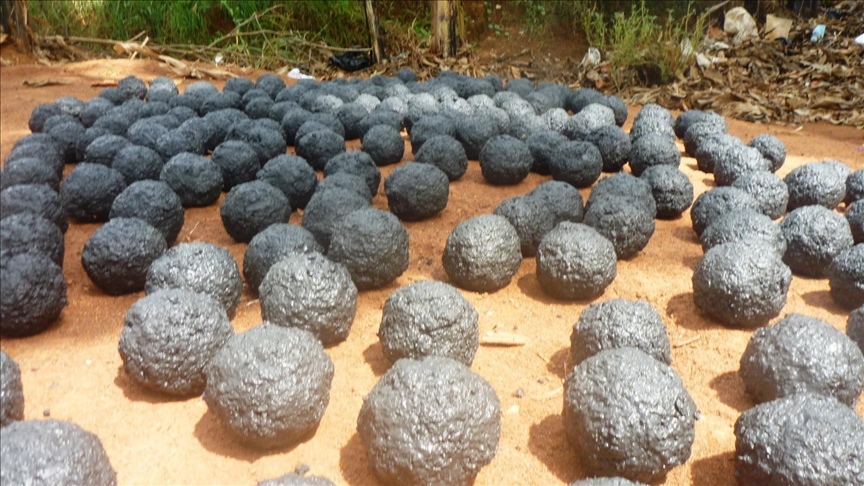Environmentally friendly green charcoal could save Uganda's forests
Officials, conservation groups promote green charcoal, made of agricultural waste and clay, to help stop deforestation

KAMPALA, Uganda
Slowly but steadily, many Ugandans are turning away from cooking over firewood and traditional charcoal, opting instead for green charcoal, a fuel proven to be more environmentally friendly.
Laden with clay or mud, green biomass charcoal does not release the billows of smoke and carbon dioxide that the conventional briquettes emit when burned and is gaining popularity in the East African country, where 80% of residents rely on wood and coal to cook their meals, according to the national statistics bureau.
Spheres or blocks of green charcoal briquettes are made of agricultural waste such as dry banana peels, coffee husks, plant and tree leaves and can be used as an alternative to other fuels such as coal and oil, both in household uses and in heating boilers in factories, among other uses.
"Green charcoal does not emit much smoke like firewood or charcoal made from trees because of the clay in which the agriculture waste is compressed," said Jack Mugasha, a senior environment official at Uganda's Water and Environment Ministry.
Listing the advantages of the fuel, Mugasha said it burns cleanly and reduces exposure to smoke that can cause respiratory disease. Further, he said it uses agricultural waste materials and therefore does not contribute to deforestation and can be paired with complementary technologies like fuel-efficient stoves to further reduce fuel consumption.
Women in villages near cities and towns in Uganda have taken up the task of making green charcoal a source of income. Winnie Nakazzi, 39, is one such woman who says she earns her living from making green charcoal.
"I've been making green charcoal for the last three years. I was taught how to make it by a local community-based women's organization whose main objective is to get people to stop using firewood, (thus) saving forests, and also to empower women to become self-sustaining," said Nakazzi.
To make the green charcoal, she first collects enough agricultural waste materials, which she dries and crushes into small pieces to mix with the wet clay or mud. She then gives the individual briquettes their round or block-like shapes with her hands, laying them on the ground to dry up for three days.
"I sell each heap of about 15 briquettes at 2,000 Ugandan shillings (roughly $0.50). The market is assured. Many people are turning to use the charcoal we make rather than the traditionally made charcoal because it emits very little smoke if any. It's also economical because six briquettes can cook beans for 4 people."
Nakazzi, a single mother, says she uses the money she earns from selling green charcoal to feed and pay for the school fees of her three children.
One of her customers, Yusuf Ogoli, said that ever since he started using green charcoal, he stopped using briquettes made from wood. "It's far more economical and it's smokeless. The only disadvantage is that it takes time to catch fire."


Authorities promote green fuel's production
Green charcoal can also be used to cook for much larger groups in institutions like prisons and schools. The headteacher of a primary school in Kyampisi, roughly 35 kilometers (22 miles) from the capital Kampala, said that for last the seven months, they had been using green charcoal to cook food for their students.
"Our cook introduced the idea of using it, saying it was cheaper and safe. I bought his idea but I have no regrets because we now spend less money for buying charcoal," said Rogers Okello.
Authorities and environmental groups also promote green fuel production as a way to save the country's forests, said Ignatius Mande, a forestry official in the central district of Mukono.
He said: "Making and using green charcoal is being promoted in Uganda by government, environmentalists and non-governmental organizations as one of the ways of reducing the cutting down of trees in the country."
Mande remarks echoed those of Minister of State for Environment Beatrice Anywar, who had said in a recent interview: "In order to save our forests, we should encourage people to use green charcoal. We encourage Ugandans to use it instead of using charcoal made from trees."
At larger scales, green charcoal is manufactured by agricultural waste materials are carbonized in a kiln made from a metallic container like a drum barrel, according to industrial chemist Jerome Kaketo, explaining that the carbonized material is then crushed and formed into briquettes using a small press and a binder made from clay or starch from the cassava plant.
Conservation of trees has become increasingly important in Uganda over recent years, with the country's former 32% forest and woodland cover -- roughly 75,000 square kilometers (29,000 square miles) -- in the 1980s now down to less than 15%.
Recent studies by the Africa Natural Resources Institute suggest that Uganda loses an estimated 200,000 hectares (494,000 acres) of forest cover per year. According to the study, Uganda may not have any forests left in the next 83 years due to logging and rapid human population growth. Many hope that the use of green charcoal could help change that trend.
Anadolu Agency website contains only a portion of the news stories offered to subscribers in the AA News Broadcasting System (HAS), and in summarized form. Please contact us for subscription options.







